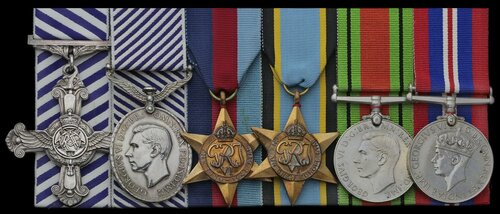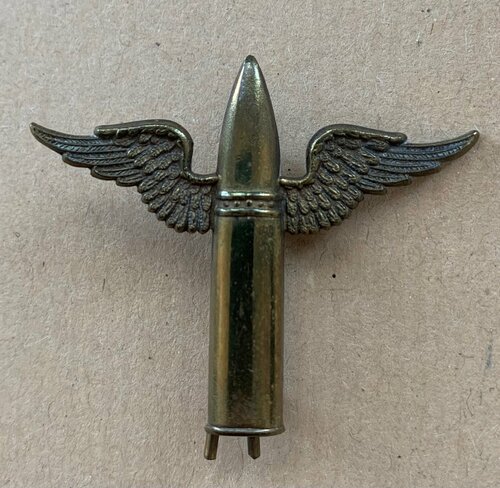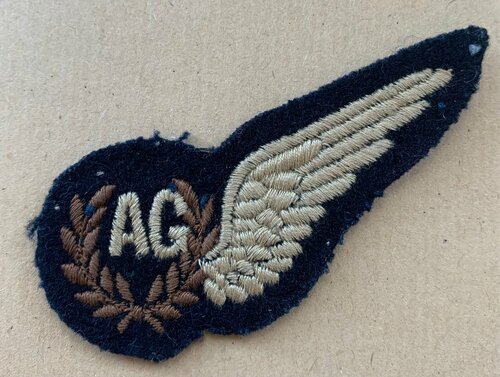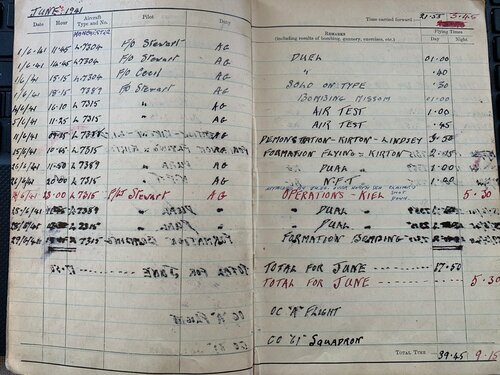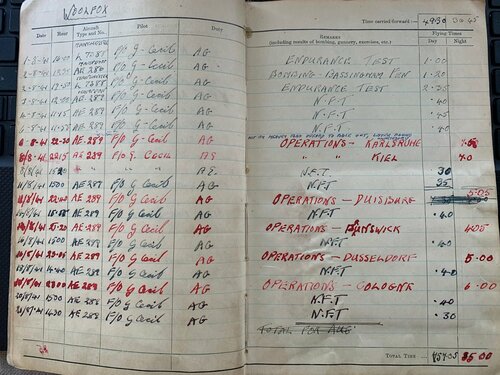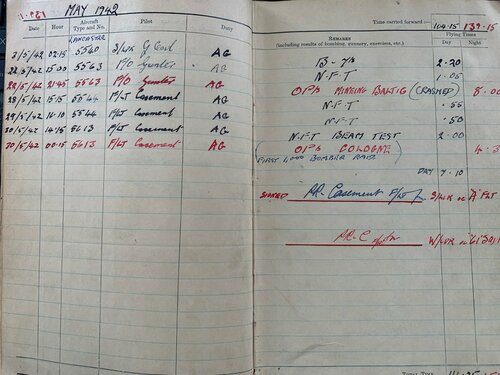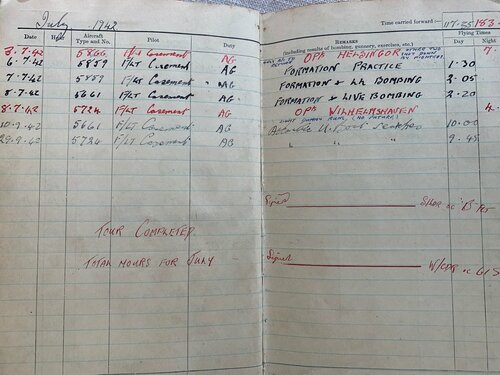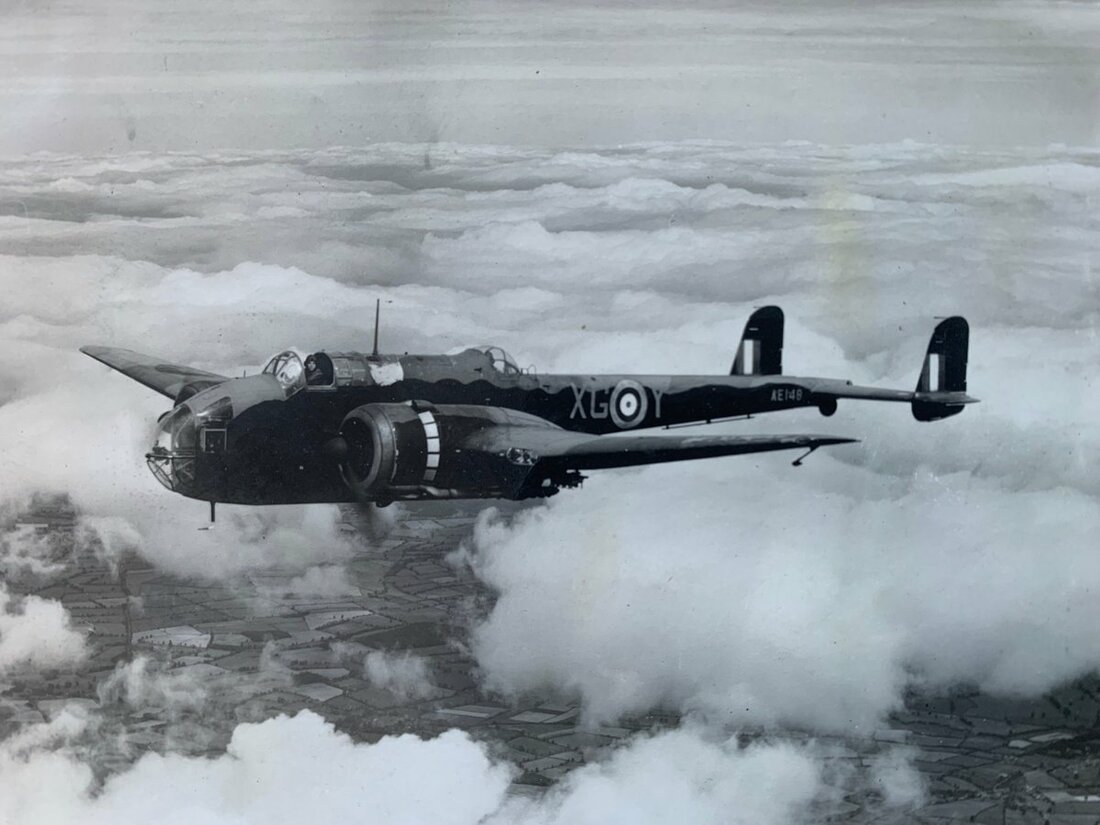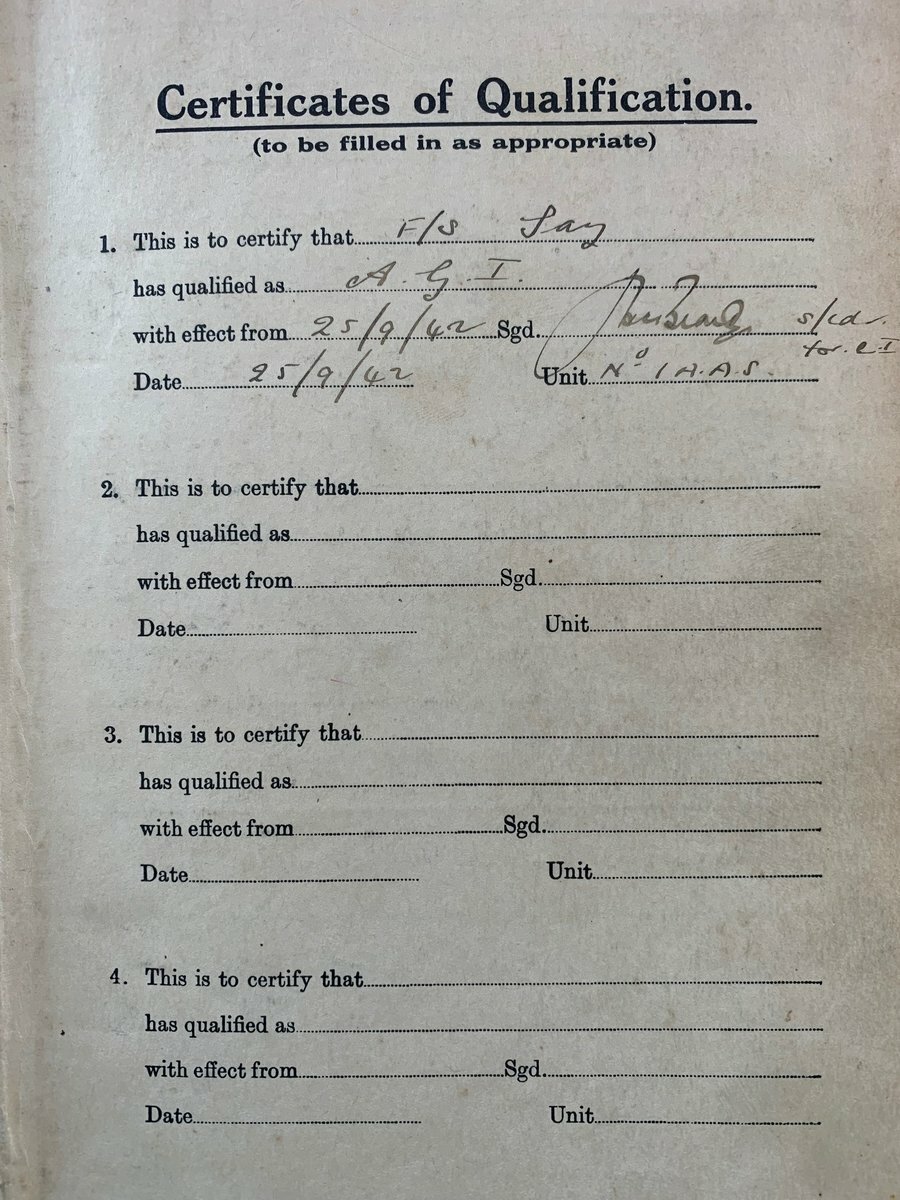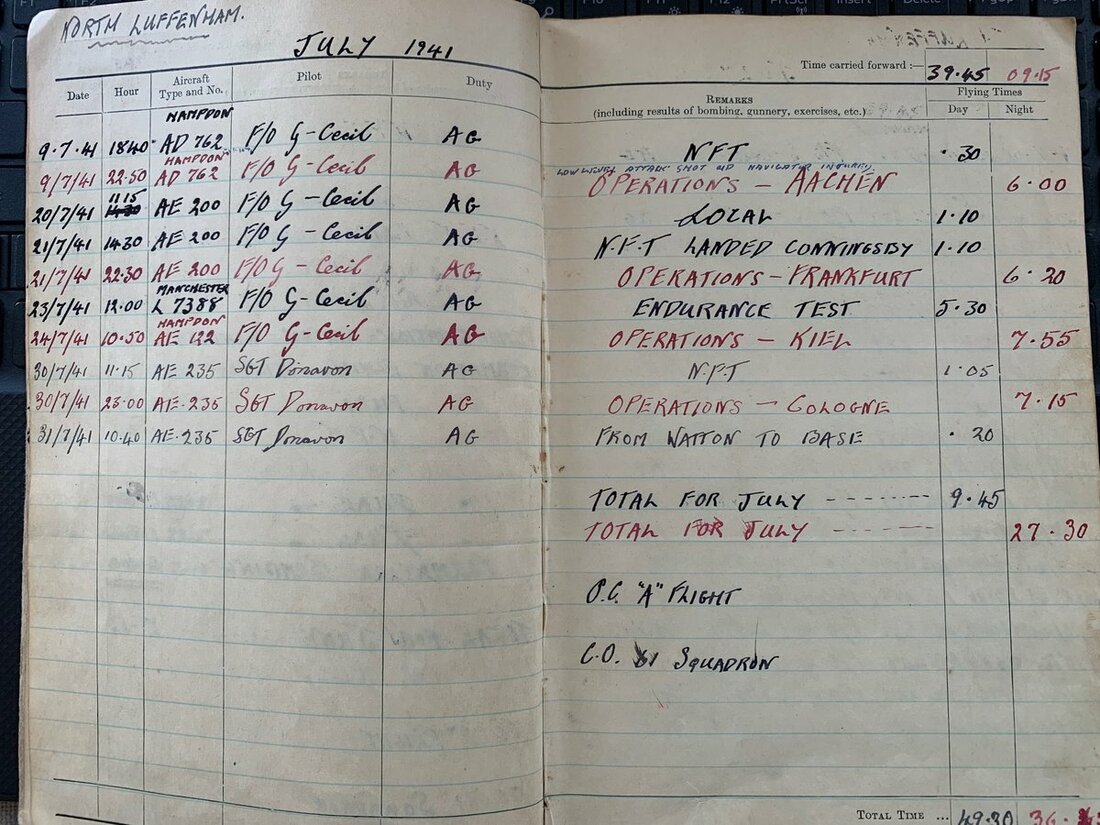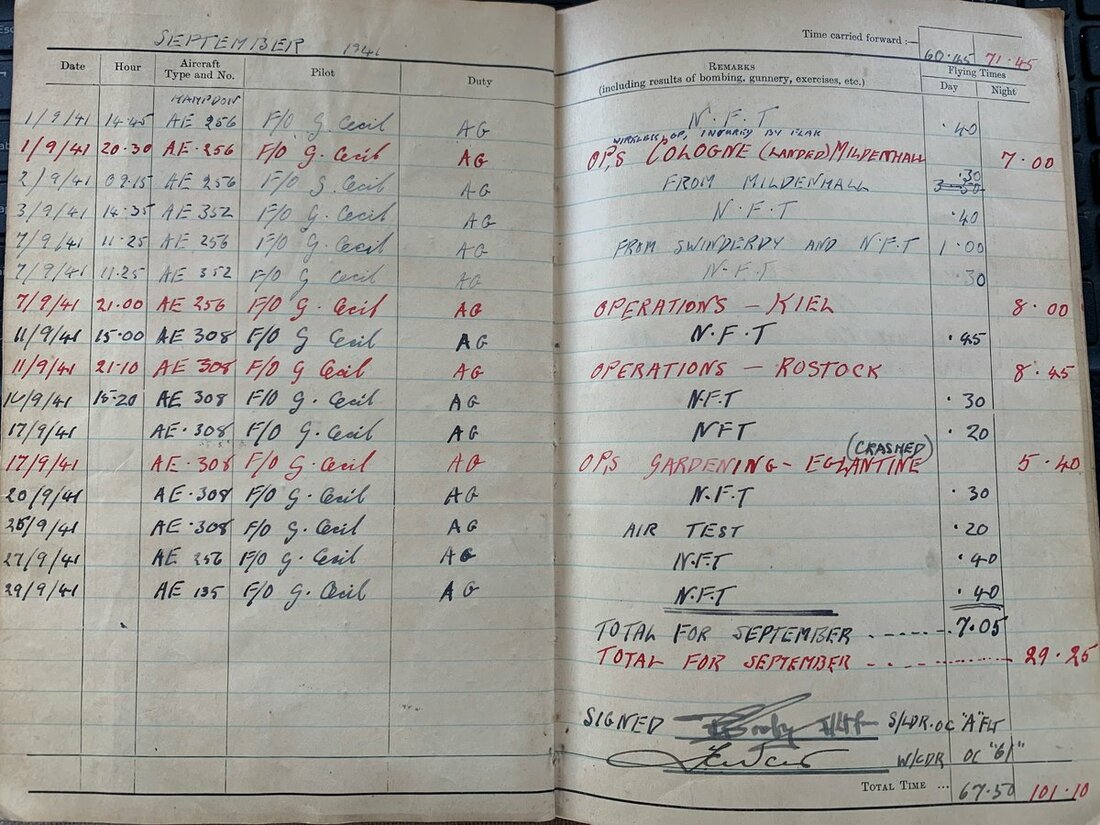Auction: 21003 - Orders, Decorations and Medals
Lot: 547
(x) A Second War 1943 D.F.C., 1942 D.F.M. group of six awarded to Hampden, Manchester and Lancaster Air Gunner, Flight Lieutenant L. R. Say, No. 61 Squadron, Royal Air Force Volunteer Reserve, who flew no less than 53 Operational sorties with the Squadron, including the attack on the Nazi Headquarters at Aachen, 9/10 July 1941; to Karlsrühe 6/7 August 1941, when Say was knocked unconscious during a lightening strike on his aircraft - before returning to his station and putting out the flames; the attack on Billancourt Renault Factory, 3/4 March 1942 and on the first 1,000 Bomber Raid on Cologne on 30 May 1942
Distinguished Flying Cross, G.VI.R., reverse officially dated ‘1943’; Distinguished Flying Medal, G.VI.R. (1154059. Sgt. L. R. Say. R.A.F.); 1939-45 Star; Air Crew Europe Star; Defence and War Medals 1939-45, generally good very fine (6)
Another group to Say, but without the original Flying Log Books, were sold at DNW in 2017.
D.F.C. London Gazette 19 October 1943:
‘Since the award of the Distinguished Flying Medal this officer has completed many operational missions as air gunner. On one occasion, his turret became unserviceable immediately on leaving base and had to be operated manually throughout a long and arduous flight. Pilot Officer Say has frequently displayed a fine fighting spirit when his aircraft has been attacked by enemy night fighters. He has always shown high courage and devotion to duty.’
D.F.M. London Gazette 22 September 1942:
‘Flight Sergeant Say has taken part in bombing operations against the majority of the main targets in Germany and occupied territory including Berlin, Kiel, Essen, Rostock, Bremen, Wilhelmshaven and the Renault Works, Paris. He acted as Air Gunner in two crews - the Captains being Flt. Lt. Gascoyne-Cecil, D.F.C., and Flt. Lt. Casement, D.F.C., both of whom have achieved consistently successful results. By his example in the air and on the ground, Flight Sergeant Say has gone far to maintain a high standard of morale and efficiency throughout all Air Gunners on the squadron. He is held in high esteem by Captains of aircraft and Air Gunners alike. On one occasion whilst returning from an attack on Karlsrühe, the aircraft in which he was flying entered a violent electric storm. The aircraft was struck by lightning or static electricity, the wireless set took fire and Flight Sergeant Say became temporarily stunned. Despite the fact that the aircraft became temporarily out of control and almost turned on its back, Flight Sergeant Say rendered valuable assistance to the Wireless Operator in extinguishing the fire.’
Leonard Robert Say was born at Bleadon, Weston-Super-Mare, in November 1920. He enlisted in the Royal Air Force for training as an Air Gunner in May 1940. Having completed his training he was subsequently posted as a Sergeant for operational flying with 61 Squadron (Hampdens), Hemswell. He flew his first Op on Kiel on 26 June 1941. When his 1st Tour finished with a trip to Wilhelmshaven on 8 July 1942, he had completed 33 Operational sorties with the Squadron in Hampdens, Manchesters and Lancasters, including: the raid on the Nazi Headquarters at Aachen, 9/10 July 1941, when his pilot was Flying Officer Gascoyne-Cecil and their Hampden ‘ran into a cone of searchlights before approaching Aachen and was attacked by a fighter with a headlamp. Violent evasive action was immediately taken and the enemy aircraft was believed hit by F/O Gascoyne-Cecil’s guns. The Wireless Operator, F/Sgt. Beck, was wounded on the back of the left hand but continued to operate his wireless set. F/O Gascoyne-Cecil attacked the target and bursts were observed close to a railway junction’ (Squadron Operations Record Book refers); Karlsrühe 6/7 August 1941, when Say was knocked unconscious before returning to his station; Boulogne; Kiel; the Billancourt Renault Factory, 3/4 March 1942, when with the same pilot they ‘dropped... nickels and then attacked the target from 4,000 ft in a level attack, his bomb bursting in the target area. Near Paris he was fired upon by an unidentified twin-engined aircraft, and his tail gunner F/Sgt Say returned the fire from 150 yards. The enemy aircraft turned away at 50 yards and was not seen again’ (Ibid); Essen; Gardening off Swinemunde, 22/23 May 1942, when his pilot was Flying Officer L. B. Gunter and their Lancaster ‘pinpointed on the coast near Swinemunde, but was picked up by searchlights, and an enemy fighter. Evading fighter and S/Ld [searchlight] a second run was made, and the load accurately planted. Returning to base in the early morning mist the port undercarriage collapsed on landing’ (Ibid); Gardening in the Danish Sound and an attack on Wilhemshaven, both piloted by Flight Lieutenant P. R. Casement. The latter, just over a week after the raid on Wilhelmshaven, was to captain a crew which was to become the first Bomber Command crew to bring back irrefutable evidence that they had destroyed a U-boat at sea - a photograph showing the U-boat crew in the water swimming away from their sinking vessel.
Say advanced to Flight Sergeant, and was posted as an instructor at the end of July 1942. He was commissioned Pilot Officer into the Royal Air Force Volunteer Reserve in June 1943, but had returned to operational flying with his old Squadron on 28 February, flying on St Nazaire with Squadron-Leader Cecil. No. 61 Squadron, now operating out of Syerston, continued to carry out missions to heavily defended targets and Say was now crewed with Wing Commander W. M. Penman. In August 1943 they took part in sorties to Milan, Nurnberg and Berlin. Say flew his last operational sortie with the Squadron when piloted by Squadron Leader E. C. Benjamin to Berlin, 3/4 September 1943. He was posted as an instructor to No. 16 O.T.U., Upper Heyford, 15 September 1943, with the most impressive record of 53 Ops, a fine 'half-century' indeed.
Promoted to Flying Officer in December 1943, Say was posted to HQ Bomber Command the following month. He advanced to Flight Lieutenant in June 1945. Say was forced to relinquish his commission due to ill health in 1948. He died at 16 Wadham Street, Weston-Super-Mare, in October 1978.
Sold together with his Observer's and Air Gunner's Flying Log Book, with entries from 27 November 1940-11 June 1945, including all of his Operational Sorties, besides Air Gunner's brevet and Badge and Guide for Precautions if in the hands of the enemy booklet.
Subject to 5% tax on Hammer Price in addition to 20% VAT on Buyer’s Premium.
Estimate
£3,800 to £4,200
Starting price
£3600

